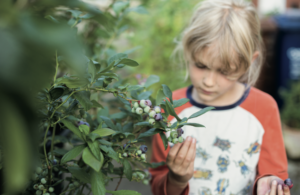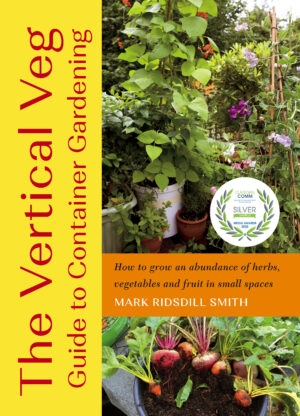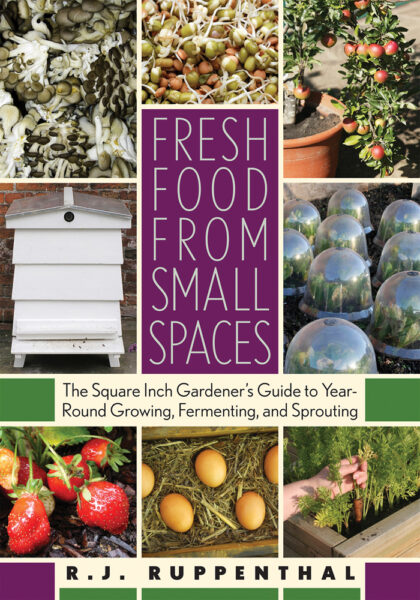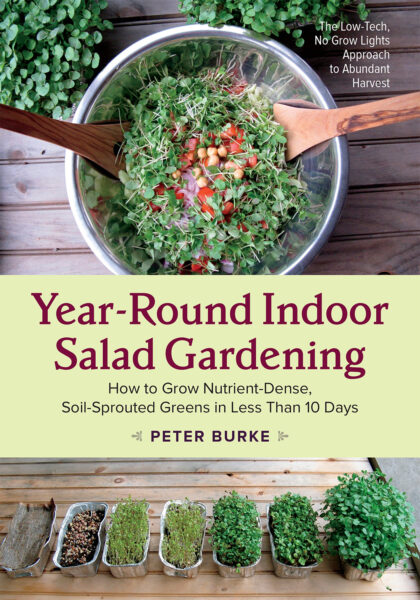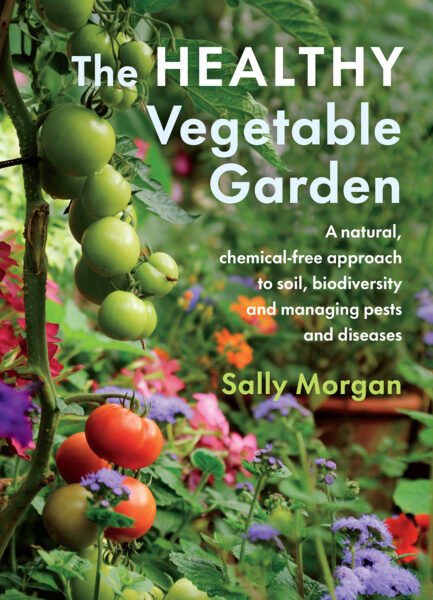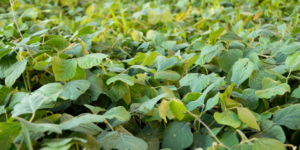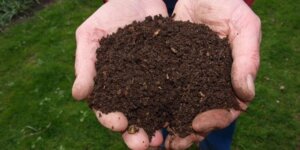Why You Should Try Container Gardening
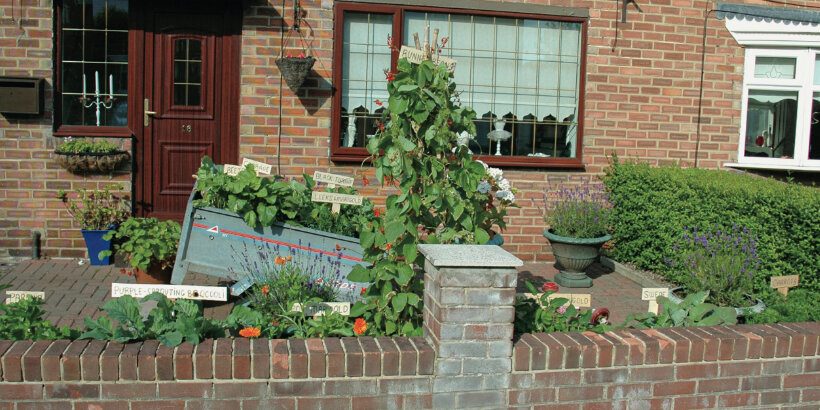
There are countless reasons to grow at home, from eating more healthily to saving money on your grocery bills. We can’t list them all here, but we can outline three very good reasons to try container gardening. (If you’d like more, take a look at The Vertical Veg Guide to Container Gardening. Mark Ridsdill Smith devotes an entire chapter to the many reasons you should give growing a shot.)
The following is an excerpt from The Vertical Veg Guide to Container Gardening by Mark Ridsdill Smith. It has been adapted for the web.
Grow for Food Security
The idea that food growing in small spaces could make any meaningful contribution to food security is usually overlooked or dismissed without further thought. But my experiments and rough calculations show that it is possible to grow in the region of 5–15 percent by value of a household’s food in a small space like a patio, balcony or front yard. This isn’t insignificant.
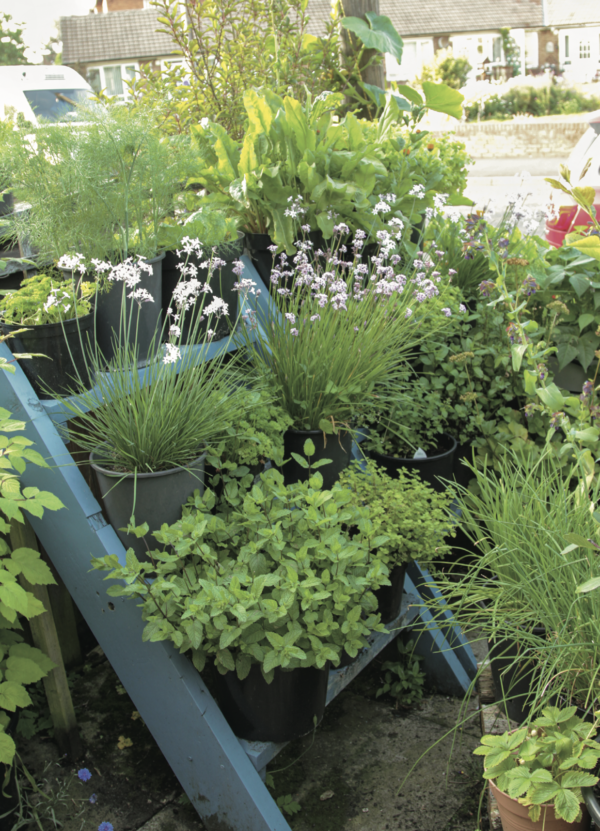
Only a small space is needed to provide some fresh, highly nutritious food that can make a difference to the quality of our diets.
True, small-space urban growing can never meet all – or even a major part – of our food needs. Most high-calorie cereal crops need more space than is easy to find in cities. However, small urban spaces are highly suitable for growing salad leaves, herbs and soft fruit. These are high in value and nutritional content. By growing these at home, more of us can supplement our diets with super-fresh, affordable and nutritious food. In the UK, for example, we have to import around half the food we need, which makes us vulnerable to any disruptions, whether that be from trade disputes, climate disasters (such as damage to crops from bad storms and flooding, which are already on the rise), or other natural or manmade catastrophes. In times of food shortage, small-space growing has the potential to make a big difference to the quality of our diets, enabling governments to focus efforts on non-perishable staples like wheat and rice.
For the future, urban food growing – in small spaces at home, at community projects and in urban farms – also has the potential to change the way we structure our food system. We can make it more efficient and less wasteful by growing most of our perishable food, like soft fruit and salad, closer to where we need it. This would mean that the food we transport would be mainly non-perishable items like rice, pulses and cooking oil, reducing the need for refrigerated storage and transport.
There are millions of us in cities with enough space to grow a little food at home. If we can support more people to grow, there is the potential to make a significant contribution to our food supply, as well as provide more nutritious food – and re-skill the population in the art of growing food. In our uncertain future, farming and food growing is likely to become increasingly important. As farmer and writer Brenda Schoep says on her website: ‘My grandfather used to say that once in your life you need a doctor, a lawyer, a policeman and a preacher but every day, three times a day, you need a farmer.’ In an era of ‘cheap’, abundant food, it’s easy to forget how reliant we are on those who grow food for us.
Grow for and With Children
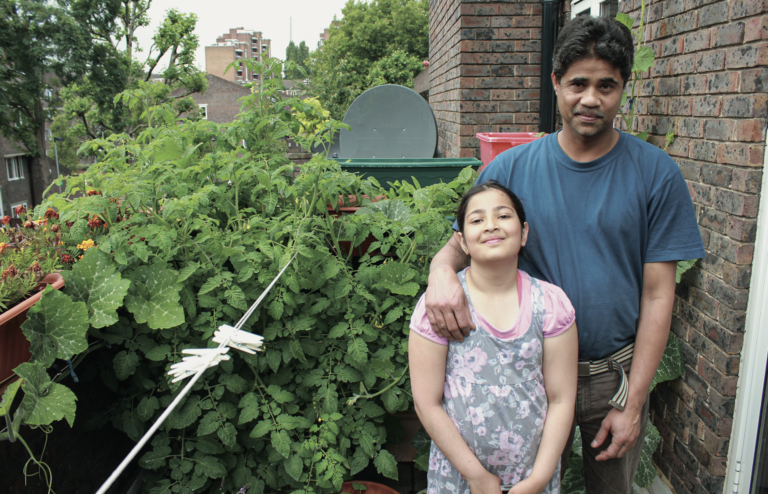
After moving to London from a home with a garden in Bangladesh, Helal Ahmed found joy in being able to grow with his daughter on his balcony in Somers Town, London.
Most kids love getting their hands into the soil, sowing seeds and watching them come up. There is something totally different to the whole experience of picking, podding and eating a freshly grown pea than a bowl of boiled peas from the freezer. Or of getting purple-stained fingers after popping blackberries and raspberries straight into the mouth from the plant, instead of eating them from a plastic punnet.
Living plants offer a fuller sensory experience that encourages greater experimentation. I’ve done workshops with children who don’t normally eat much salad and watched them polish off whole trays of pea shoots and even strongly flavoured land cress. Children also love picking and scrunching fresh herbs, immersing themselves in the smells and concocting their own perfumes and magic potions.
Container growing at home offers those of us without gardens the opportunity to grow with our children, grandchildren and next-door neighbours. There is something a bit miraculous about being able to give children the chance to pick berries and leaves in the middle of the city.
If you are growing with kids, you’ll want to grow things they like to eat. Tom Moggach, who runs the outdoor learning at Rhyl Primary School in London, helped compile this list of kids’ favourites:
- Sorrel – a popular plant that has a lemony kick.
- Strawberries – alpine strawberries fruit over several months and make the perfect foraging snack.
- Pea shoots and trays of other microgreens – everybody loves these.
- Podded peas – make a nice alternative for the lunchbox.
- Nasturtiums and other edible flowers – for the fun and novelty of eating flowers.
- Potatoes – children love harvesting potatoes!
And anything else that captures kids’ imaginations – for example, growing some of the ingredients for their favourite dish, maybe tomatoes and basil for a pizza. My daughter loves the Chilean guavas and the Japanese wineberries that we grow.
Other fun activities to do with kids in a small container garden include bug hunts, making herb potions and perfumes, setting up a wormery, making bamboo wigwams for runner beans, decorating signs and labels for plants, making an urban scarecrow, drying herbs to make tea, potpourri or lavender bags, making a basin pond, saving seeds (such as tomato, sunflower or nasturtium) or growing some microgreens or storecupboard seeds (for instance, coriander, mustard, fennel or chickpeas).
People who decide to grow food later in life are often heavily influenced by memories. of growing as a child. It’s another reason to give children the chance to grow.
Grow for Well-Being at Work
A lot of workplaces have an empty rooftop, car park or other place where plants can be grown in containers. As well as looking good and creating relaxing and creative spaces, office container gardens can be used to bring employees together and provide salad ingredients for staff lunches and fresh herbal teas as well as healthy fruits and rejuvenating fragrances like lavender.
An office container garden can be designed to reflect the organisation and the interests of its employees. Some staff might be motivated by a recycled garden, others by a beautiful or fragrant garden. Design the garden to take into account the time and resources available. Even a few well-chosen pots can look good, create a talking point, and will not be too much work to maintain.
Herbs and fruit trees are relatively low-maintenance and offer beauty and fragrance as well as leaves to pick for fresh herb teas or fruits to snack on. Alternatively, for a quick, one-off growing project, a crop of microgreens can be grown in just two or three weeks and then shared in a communal meal. Or a variety of different chillies can be grown for an office chilli-tasting session.
It is also possible to reduce food waste in the office by composting it and then using it in the gardens.
Don’t overlook the fact that container gardens do need regular attention. Any successful office garden needs one or two people to oversee it and a daily watering routine (or an automatic watering system). An afterwork or lunchtime gardening session once a week or month can be a nice way for people to get together and keep on top of the seasonal jobs at the same time.
Recommended Reads
Recent Articles
Want to see your crops thrive this upcoming growing season? The key is in soil fertility and health. Spend time maintaining your soil’s health to guarantee bigger and better crops come harvest time! The following is an excerpt from No-Till Intensive Vegetable Culture by Bryan O’Hara. It has been adapted for the web. What Is Soil Fertility?…
Read MoreIt’s time to take control of your seeds and become a plant breeder! Saving your seed allows you to grow and best traditional & regional varieties, and develop more of your own. The following excerpt is from Breed Your Own Vegetable Varieties by Carol Deppe. It has been adapted for the web. Becoming A Plant…
Read MoreRewilding is one of the best things you can do for the biodiversity of your farm or garden. By no longer mowing your lawn, flowers will start to grow, creating a meadow and a habitat for creatures that often get forgotten. The following is an excerpt from The Healthy Vegetable Garden by Sally Morgan. It…
Read MoreTrying to figure out how to manage weeds in your garden beds? Use cover crops and living mulches for weed suppression while your garden flourishes! The following is an excerpt from The Ecological Farm by Helen Atthowe. It has been adapted for the web. Suppressing Weeds With Cover Crops: Getting Started Cover crops suppress weeds…
Read MoreTo turn a barren lot into a permaculture paradise, you’ve got to start from the ground up — and sheet mulching is an easy way to start. Here are some tips to help you strengthen your soil with the power of sheet mulching! The following is an excerpt is from Perennial Vegetables by Eric Toensmeier. It…
Read More

